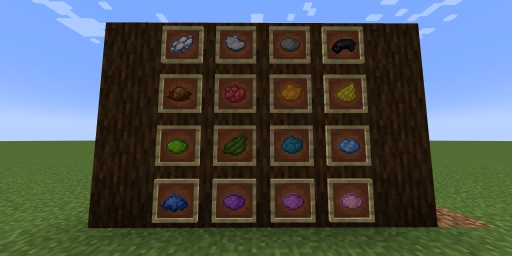Despite its many limitations, Minecraft offers some exciting customization options for your blocks and projects. Dyes are extremely important as they allow you to color some cool items and add even more variety to your world. Dyes have been included since the earliest versions, but they were long only useful for wool. Nowadays, you can dye many other items and tailor them to your preferences! Today, we’ll show you how to obtain all dyes, where to use them, and which automatic farms you can utilize to make the process easier.
Crafting and Using All 16 Dyes
In Minecraft, you can craft sixteen different colors. While some require just a single item, others need to be combined. Those who paid attention in art class might find this quite familiar. Flowers and other items can be transformed in the crafting menu, while some other blocks need to be smelted to obtain the dye. Additionally, with some luck, you can acquire all dyes from the wandering trader by trading one emerald for three colors.
We’ve summarized all possibilities in this table for you!
| Color | Crafting | Locations | Combination |
|---|---|---|---|
| White | Bone Meal | Lily of the Valley, Trail Ruins (Suspicious Gravel) | - |
| Light Gray | Oxeye Daisy, Porcelain Star, White Tulip | - | Black + 2x White / Gray + White |
| Gray | Closed Eye Flower | - | Black + White |
| Black | Ink Sac, Wither Rose | - | - |
| Brown | Cocoa Beans | - | - |
| Red | Poppy, Rose Bush, Beetroot, Red Tulip | - | - |
| Orange | Orange Tulip, Torch Lily, Open Eye Flower | Trail Ruins (Suspicious Gravel) | Yellow + Red |
| Yellow | Sunflower, Dandelion, Wildflowers | Villages (Mason’s House), Trail Ruins | - |
| Lime | Smelt Sea Pickle | - | Green + White |
| Green | Smelt Cactus | Villages (Desert) | - |
| Cyan | Pitcher Plant | - | Blue + Green |
| Light Blue | Blue Orchid | Trail Ruins (Suspicious Gravel) | Blue + White |
| Blue | Lapis Lazuli, Cornflower | Trail Ruins (Suspicious Gravel) | - |
| Purple | - | - | Red + Blue |
| Magenta | Lilac, Decorative Allium | - | Pink + Purple / Red + Blue + Pink / 2x Red + Blue + White |
| Pink | Peony, Pink Tulip, Pink Petals, Cactus Flower | - | Red + White |
Applications for Dyes in Minecraft

Dyes are now used to color a variety of blocks. They also help distinguish items from one another, so you don’t lose track quickly. Fundamentally, all these items can only be dyed in 16 different colors, but there is one exception where you can create over 5 million color combinations!
Wool: Colored wool is likely familiar to every player, mainly because sheep can spawn in different colors. You can color wool any way you like with a right-click.
Carpets: You can create carpets from dyed wool, and you can also recolor already crafted carpets.
Glass: Transparent glass can be tinted with dyes, creating some really cool effects! Naturally, you can also make stained glass panes in all 16 colors from stained glass. A fun trick is to place stained glass panes on a beacon (Building a Minecraft Beacon: All Effects & Materials Explained!) to change the color of the light beam. More than 16 colors are possible here.
Concrete: Concrete powder can be crafted from one dye and four each of sand and gravel. When the block comes into contact with water, it turns into concrete. Concrete features very vibrant colors, perfect for colorful buildings or structures!
Terracotta: You can find terracotta in mesas or by firing a clay block. With eight terracotta blocks and one dye, you can create stained terracotta. Unlike concrete, stained terracotta is darker and less saturated. Stained terracotta can also be fired to create glazed terracotta with intricate patterns.
Banners: Combined with banners, dyes are incredibly versatile! You can create single-color banners or combine endless patterns and colors. Banners can mark waypoints on a map or be placed on your shield.
Shulker Box: To better organize your inventory, you should definitely dye your Shulker boxes in different colors. We discussed this in a separate article (Efficient Inventory Management in Minecraft: Tips and Strategies) .
Beds: While only red-covered beds were available for a long time, you can now choose various colors. Villages also have pre-dyed beds.
Candles: Candles can be crafted from honeycombs and string, and you can dye them in any of the 16 colors.
Bundles: You should also dye bundles to better differentiate them in your inventory. You can dye them as you wish if you change your mind.
Firework Star: Fireworks are mostly used for Elytra, but by adding a colored firework star to the crafting recipe of paper and gunpowder, you can create beautiful rockets. Each star can have eight colors, and additional colors can create transitions. We think this is a much-underused feature in Minecraft!
Signs (Text): You can change the text color on a sign with a right-click. This can make the text easier to read. You can also outline it brightly using a glow ink sac.
Collars (Wolf and Cat): You can change the collar color of tamed cats and wolves to make them even more unique!
Villagers (Shepherd): Almost all dyes can be traded for a stack of 12 for an emerald. In return, you can get various dyed items like wool, carpets, banners, or beds.
Special Cases: Leather Armor and Horse Armor

Leather armor, horse armor, and wolf armor can also be dyed, and you have significantly more colors to choose from—over five million, to be exact! In Java, you just need to combine any colors in the crafting menu. It’s best to use an online guide to perfectly match your desired shade. The feature of dyeing the water color in a cauldron and using it to change the leather armor is only available to Bedrock players.
Automation: Efficient Dye Production

All methods of obtaining dyes are renewable. You don’t have to worry about running out of options. Since most dyes are derived from flowers, a suitable flower farm is your starting point. But other automated processes are also available.
For all farms we have already discussed in other posts, we will of course include a link:
- Flower Farm (Minecraft Flower Farm Guide: How to Build an Automatic Flower Farm for Dyes and Bees)
- Sniffer Farm (Minecraft Sniffer Farm: Automatic Methods for Rare Crops)
- Bone Meal Farm (How to Build a Minecraft Monster Trap: Automatically Gather Endless Resources)
- Wither Rose Farm (Defeating the Minecraft Wither – How to Conquer the Strongest Boss!)
- Eye Flower (Minecraft Pale Garden & Creak – New Biome & Dangerous Mob in Update 1.21)
- Cactus Farm (Building a Minecraft Cactus Farm: The Ultimate Guide for an Automatic Cactus Farm)
- Ink Sac Farm
- Cocoa Bean Farm
- Sea Pickle Farm
- Wool Farm (Minecraft Wool Farm Guide: Easily Farm Automatic Wool in All Colors)
Conclusion
With dyes, you can color many blocks in Minecraft and give your world a vibrant touch. The application now goes far beyond wool, with blocks like concrete and terracotta being perfect for various building projects. Rent your own Minecraft server with us and use some of the automatic farms to ensure you always have enough dyes available. You should definitely try some of the examples, such as the firework stars or dyeing signs, for your world.
More interesting articles
Minecraft Flower Farm Guide: How to Build an Automatic Flower Farm for Dyes and Bees
Building a Minecraft Farm: Simple Guide for Food and Resources
Simple Micro Farms for Minecraft: Compact and Automated
Build an Automatic Chicken Farm in Minecraft: Unlimited Eggs, Feathers & Chicken Meat
Minecraft Guide: Automatic Potato and Carrot Farm for Unlimited Food and Smart Trading Options




